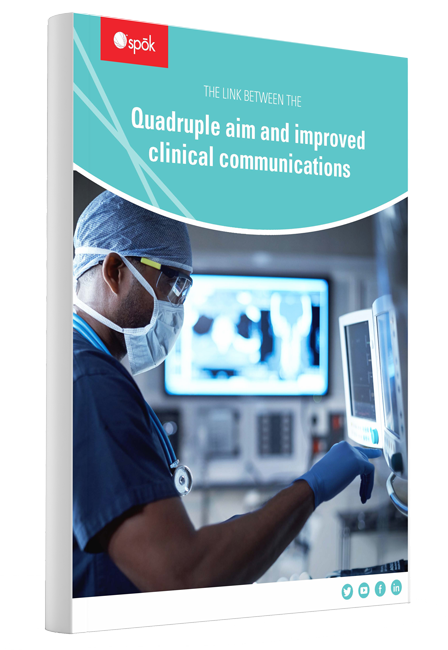Blog
The link between the quadruple aim and improved clinical communications

- Improving clinical communication contributes to achieving the quadruple aim by enhancing patient outcomes, reducing healthcare costs, and improving patient and clinician experiences.
- Efficient communication enables seamless information exchange, helps prevents errors, and promotes better care coordination.
- Implementing a healthcare communication and collaboration platform streamlines workflows, increases productivity, and fosters a positive work environment.
How can you work towards the four pillars of the quadruple aim by improving efficiency with faster, smarter clinical communications?
Working toward the quadruple aim requires hospitals and health systems to establish environments that are more conducive to efficiency and patient care. After all, patient care is the whole point. Improved efficiency is an all-around win for both patients and providers.
One area that plays a vital role in achieving these aims is clinical communication. Poorly designed workflows that don’t support effective care team interaction will fail, and clinician satisfaction will continue to suffer. Having a clinical communication and collaboration (CC&C) platform can help physicians avoid burnout and achieve the Quadruple Aim. Dr. C. William Hanson, chief medical information officer at Penn Medicine, says that when it comes to CC&C tools, such as secure messaging apps, “You don’t have to go to the information; the information comes to you. Somebody doesn’t have to interrupt your meetings. They can text you, and you can handle questions based on their importance.”
This eBook examines each of the four pillars of the quadruple aim in the context of how faster, smarter clinical communications can have a meaningful impact in each area. Zeroing in on communication-related hurdles in your organization and implementing a healthcare CC&C platform is a solid place to start on the path toward realizing the quadruple aim.
The role of communication in…
1. Improving patient outcomes
Seamless information exchange among healthcare providers ensures that all team members are well-informed about the patient’s condition, treatment plans, and any changes in their care. By promoting clear and timely communication, healthcare teams can prevent errors, reduce adverse events, and improve patient outcomes. Rock-solid communications are the foundation for achieving better patient outcomes. When providers can’t find one another, test results linger in the EHR awaiting the next login, or if the rapid response team can’t be notified quickly, patient safety suffers. By sharing relevant information, healthcare teams can identify trends, manage chronic conditions, and implement preventive measures more effectively.
Many of the adverse effects of communication breakdowns such as these are due to manual processes or poorly designed workflows. Taking an enterprise approach leads to a reduction in these breakdowns, improves response times to clinical events, and uses your hospital’s resources more efficiently.
2. Reducing healthcare costs
Healthcare margins are notoriously slim. In the wake of the COVID-19 pandemic this is truer than ever before. Technology investments must be well vetted and aligned with detailed business cases. When it comes to the role of communications, investments in point solutions for clinical communications add up and don’t always prove successful once implemented, escalating costs and inefficiency.
By streamlining communication processes, eliminating unnecessary redundancies, and reducing medical errors caused by miscommunication, healthcare organizations can minimize waste and unnecessary healthcare expenditures. A single care collaboration platform can reduce clinicians’ wasted time daily by connecting care teams and enabling better productivity, thus reducing operating costs.
Clear communication among providers also ensures that resources are appropriately allocated, preventing duplication of tests, procedures, or treatments. Improved care coordination, facilitated by effective communication, enables efficient transitions of care, reducing hospital readmissions and associated costs.
3. Improving the patient experience
From the uncomfortable beds and unfamiliar smells to the worry over pain, treatment, and expense, having a positive experience in a hospital isn’t easy. A satisfying, high-quality patient experience takes the full attention of a well-trained care team—and communication practices that make the many handoff points happen seamlessly. This is true in both virtual care and in-person care environments. When patient handoffs happen smoothly and in a more efficient manner, clinicians can feel better throughout their workday, which reduces burnout levels and enables them to truly focus on their patients. Additionally, strong communication fosters patient engagement, enabling patients to actively participate in their care decisions, resulting in higher satisfaction levels.
4. Improving the clinician experience
We know that the environment for clinicians is fraught with difficulty. Technology fatigue, endless rounds of phone tag, too many alerts, having a mountain of administrative tasks to complete, and even the threat of workplace violence cause exhaustion and burnout. It’s imperative to improve efficiency across the board, especially when it comes to how people interact with one another and with the technology they rely on to do their jobs. Moreover, research on the mental health implications among healthcare workers during the COVID-19 response has shown that the pandemic had a major impact on mental health, both in the general population and vulnerable groups. Yet, risk factors for burnout have been magnified by extremely high demands, lack of control, resource scarcity, and possible ethical dilemmas. Secure and user-friendly communication platforms facilitate efficient message exchange, care coordination, and interdisciplinary collaboration, improving workflow efficiency and reducing administrative burdens. Enhanced communication fosters a sense of teamwork and shared responsibility among healthcare professionals, leading to a more positive work environment.
Download the eBook today to see how common hospital objectives can be improved through robust communications to better work towards the quadruple aim.


